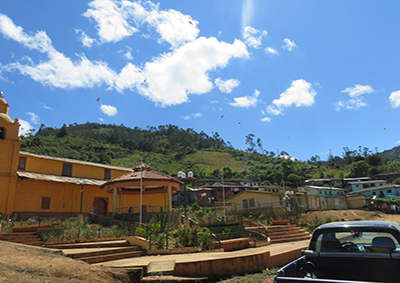The COHESION project assesses the barriers that underserved communities face when accessing Primary Health Care (PHC) to treat chronic conditions in Peru, Mozambique, and Nepal. In Peru, the selected districts are Ayabaca and Montero in the Ayabaca province of Piura, North-Peru.
The northern region of Piura is well known for its tropical climate, white-sand beaches and surf. Far from the beaches on the coast, we find the province of Ayabaca in the highlands of Piura. Ayabaca is about six hours away from Piura city and it can only be accessed by road. Rural Ayabaca has often been neglected and forgotten by policy makers and private investors. Although blessed with rich flora and fauna, the Ayabaca province faces poverty and exclusion.
The Peruvian COHESION project team chose as its intervention sites two districts of the Ayabaca province: Montero and Ayabaca, where 6,683 and 38,339 people live respectively1. According to the National Institute of Statistic and Informatics, the poverty rate in Ayabaca is 69.4% and 55.9% in Montero1. One of the main problems in these districts is the lack of access to sanitation and clean water. Ayabaca province has one of the highest drinking water shortages and lack of basic sanitation, with wide differences between its urban (54%) and rural (99%) areas2. Lack of sanitation is one of the major risk factors3 for some Neglected Tropical Diseases like neurocysticercosis.
Access to health in places like Ayabaca is crucial and yet, scarce. Health facilities in both Ayabaca and Montero only provide very basic health services, focusing on maternal and child health. Out of the 31 health facilities in Ayabaca, 29 are basic primary health care posts. The other two are health centres. Montero, on the other hand, has only three basic primary health care posts and one health centre. The health centres have few health professionals and rudimentary hospitalization facilities. If there is an emergency in either of these districts that requires an urgent referral of the patient, the closest regional hospital is located in Sullana-Piura and it takes about four hours to get there by private vehicle. However, the ambulance in these health centres is not always operating. Addressing diseases like neurocysticercosis, hypertension, and diabetes in resource-limited districts like Ayabaca and Montero needs effective interventions that work at a community-based level and that are focused on the poorest of the poor.

Health Center – Ayabaca

Pingola Main Square
References:
- Instituto Nacional de Estadística e Informática (2016). “Peru en Cifras: Ayabaca, Piura” Retrieved November 04, 2016, from https://www.inei.gob.pe/.
- Instituto Nacional de Estadística e Informática (2010). “Mapa del Déficit de Agua y Saneamiento Básico a Nivel Distrital, 2007”. Lima: Instituto Nacional de Estadística e Informática. Available at: https://www.inei.gob.pe/media/MenuRecursivo/publicaciones_digitales/Est/Lib0867/libro.pdf
- Garcia HH et al. (2016). “Elimination of Taenia solium Transmission in Northern Peru”. The New England Journal of Medicine. 2016 Jun 16; 374(24): 2335-44. Available at: https://www.ncbi.nlm.nih.gov/pubmed/27305193
